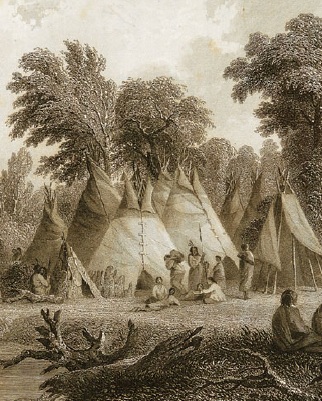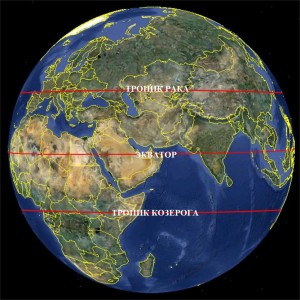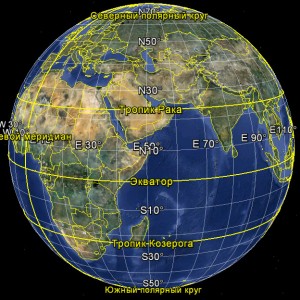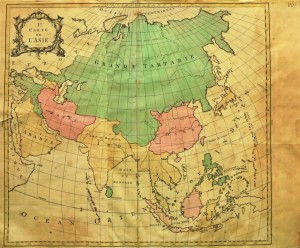It is believed that a significant role in the evolution and distribution of all types of organisms on earth, including humans, was played by cyclic climate changes that occurred on our planet with an interval of tens of thousands of years. During periods of cooling, the habitats and the number of animals decreased, and during periods of warming, the number and diversity of living forms increased, and different species settled on habitable territories - from Africa to Asia and Europe. All this was confirmed by the analysis of genomes. modern people. More and more new genetic data gradually clarify in more detail the picture of the settlement of people on different continents, the emergence of new human communities in different regions of the earth. The chronicle of man's conquest of our planet is gradually being restored using numerous genetic "evidence" (primarily from snips).
Examination of mitDNA and DNA contained in the Y-chromosome of a large number of people from different parts of the world led to the discovery of more than two hundred polymorphic marker regions, which were ultimately used for comparison. The totality of changes in markers reflected the "molecular history" of human migration. In the end, about two dozen "destinations" of the movement of migration waves were identified, which made it possible to build a genealogical tree of the human race. This was largely facilitated by the presence of unique groups of markers characteristic of certain geographically and historically isolated human populations (such as, for example, Iceland and Japan).
In general, modern ideas about the process of migration of the human population across the Earth, obtained as a result of the analysis of numerous snips in the Y-chromosome and mitDNA, are reflected in Fig. 39 on a colored insert.
Rice. 39. Ways and time of human migration on Earth, established by genetic markers. The arrows indicate the direction of migration, the different colors on the arrows indicate the times of migration (from the tab in the journal Nature, February 2001).
Different races and peoples arose after the separation of some relatively homogeneous ancestral population. In each of the groups of people, their own, very characteristic mutations independently occurred. Comparative analysis mitDNA of different populations of living people allowed us to conclude that in the Stone Age the ancestral population was divided into at least three groups, which gave rise to the African, Mongoloid and Caucasoid races. Studies by ethnogenetics point to the absence of any genetic basis for dividing people into races. People belonging to different races have very small differences in their genomes. However, these small but very specific differences between individual mitDNA lineages may indicate a Mongoloid or Caucasoid origin.
According to ethnogenomics, about 60-130 thousand years ago, a person left Africa for Asia. The first settlers from Africa reached the Near East and about 60,000 years ago settled almost the entire Asian continent. 40-60 thousand years ago, man has already mastered the lands of Australia, America and Europe.
Based on the frequencies of ancient types of mutations in the nucleotide sequences of mitDNA and DNA of Y-chromosomes in different European human populations, it was possible to reconstruct several waves of human migrations in the Old World. It has been established that the first settlers from Asia appeared in Europe 40-50 thousand years ago in the Paleolithic era. The mitDNA lines that came to Europe with the first wave of migration now make up a significant part of the mitDNA of people inhabiting the territories from northwestern Europe to the Ural Mountains. MitDNA determined that 80% of Europeans had at least seven founding mothers and ten male ancestors. According to the Englishman Brian Sykes, given in his book "The Seven Daughters of Eve", all modern Europeans are descendants of the seven daughters of the "genetic Eve". The other 27 women became the progenitors of the rest of the world's population. And one of them must be your great-great-great-great-grandmother. The conclusion regarding the number of male ancestors of the European population was made by a large international team of scientists, including researchers from Russia (headed by Professor S. A. Limborska), as a result of a large-scale analysis of the Y chromosome. In the gene pool of most European men, only ten types of this sex chromosome were found. Thus, the bulk of Europeans (about 80%) have ancestors who moved to Europe from Central Asia or the Middle East as early as the Stone Age (i.e., about 40 thousand years ago).
Of course, the statement about the ten forefathers and seven foremothers of modern Europeans should not be taken literally. Firstly, there were certainly significantly more of them (but it is still difficult to estimate the total number). Secondly, they probably lived in different eras. Scientists only argue that among all the people who lived 40 thousand years ago, very few were likely to leave direct descendants who have survived to this day. Elementary statistics predict (and we have already discussed this) that the more generations pass, the less likely it is that a particular genus with a particular Y chromosome will survive. After all, over the course of many generations, in some families several boys were born, and in others - not a single one. The result of this was that one genus (and one variety of the Y chromosome) disappeared forever, and some other genus (quite by accident) produced more numerous offspring. Ultimately, a moment must inevitably come when all the original surnames, except for one, disappear in a particular population. A similar process can be observed, for example, in small isolated settlements, where all residents can bear the same surname.
What else did geneticists read in the Encyclopedia of Man? According to modern genetic data, at the beginning of the last ice age (about 24 thousand years ago), the descendants of ancient people who came to Europe from Asia found refuge in different parts of Europe. As a result, three isolated evolutionary branches were formed: the first on the territory of present-day Spain, the second on the territory of Ukraine, and the third on the Balkans. The most unique population in terms of genetic characteristics turned out to be the Basques. It is now believed that they are the only modern representatives of the oldest inhabitants of Europe - the Cro-Magnons. Interestingly, the conclusions of geneticists are also confirmed by some of the data of linguists, indicating the uniqueness of the Basque language. Later, about 16 thousand years ago, when the ice melted, the tribes settled throughout Europe: the Spanish tribes moved to the northeast, the Ukrainian ones to Eastern Europe, and the Balkan tribes remained in Central Europe. The second wave of migration of peoples to Europe corresponds to the advance of the Neolithic agricultural peoples from the places of origin of agriculture (the region of Mesopotamia) to the north and west of Europe. In this, the genetic assessment coincided with archaeological data: the process most likely occurred during the Neolithic, approximately 7-9 thousand years ago. It was these settlers who added the missing 20% of the gene pool to European men (recall that 80% of the gene pool was obtained back in the Stone Age). Finally, another wave of migration, which corresponds to the expansion of Greek culture, occurred in the 1st millennium BC. Just before this, Moses, according to legend, led the Jewish people out of Egypt, and then led them through the desert for 40 years.
Scientists continue to study the details of migration processes that took place in the history of mankind. And gradually it became clear more interesting facts, which could only be established thanks to human DNA research. So, it was determined that the Polynesians most likely discovered America long before Columbus. Scientists came to this conclusion by comparing the DNA of the indigenous people of Samoa with the DNA of the Indian tribes of South America. In the genetics of people living six thousand kilometers from each other, a noticeable similarity was found. Probably about 500 AD, sailors from the South Pacific, moving on sailing boats, reached America. For some time, the Polynesians maintained trade relations with the indigenous population of the continent. This theory is supported by the following non-genetic fact: already around 1000 AD, sweet potato appeared in Polynesia, although this tuber was “officially” discovered only five centuries later, when Columbus visited America.
So where did people eventually come to America from? And the first answers to this question have already been received. According to DNA analysis of modern people, the ancestors of the First Americans are ancestors from Southern Siberia. Numerous traces left in the Y-chromosome have been found linking the population of America with their distant ancestors who lived in the Baikal region. The situation with female ancestors is more complicated. But one way or another, geneticists have already given a significant hint where to look for the origins of Americanism - on the territory of modern Russia. (Now the Americans have "good" reasons to claim our Siberia as their historical homeland!).
By examining mutations that have made their way into the DNA of the Y chromosome, scientists can assess how distant (in a genetic sense) males from two ethnic groups are from our common ancestor. Some of the results obtained by this method turned out to be quite surprising. For example, it turned out that the Welsh and the British are genetically almost unrelated. (Perhaps this is the reason for the constant contradictions between them). At the same time, only the Welsh turned out to be the true descendants of the Britons (the ancient inhabitants of Britain), and the modern British turned out to be genetically closest to the inhabitants of the Netherlands, where they had previously presumably lived.
Conducted DNA studies have yielded many other interesting results. So, it has always been believed that travel is the prerogative of the male. However, as analysis of mitDNA and DNA of Y-chromosomes showed, women in those distant times migrated much more intensively than men. This fact can be explained, apparently, by the fact that for most diverse human communities it has always been characteristic for women to leave after marriage for their husband's house. Thus, the migrations of women associated with marriage probably left no less, and perhaps more noticeable trace in the human genome than, say, the exodus of the Jews from Egypt or all the military campaigns of Alexander the Great.
So, without any archaeological finds and historical sources, but only using the DNA texts contained in the nuclear and mitochondrial genome of modern people, geneticists manage to restore the history of the appearance of the first people on Earth, describe their migration routes, trace deep family ties between different races, peoples and nations. This leads to an important conclusion: nature has preserved in our DNA the only reliable hundred-year-old chronicle text .
| |
History with geography recorded in our genome (ethnogenomics)Genetic landscapes (genogeography)
» Migration of ancient people
Nomads
Ancient people constantly moved around the territory in search of food. Before an event took place in the Neolithic, which was called the "Neolithic Revolution" (the emergence of agriculture and animal husbandry and the transition to a settled way of life), the tribes roamed all year round. Some of their migrations were associated with the movement of herds of game that they hunted, others were caused by natural phenomena, such as fires, volcanic eruptions, catastrophic droughts, which drove people from their familiar territory. The onset and end of the ice age (16-10 thousand years BC) strongly influenced the movement of people and climate change. The number of people on our planet was constantly increasing, which also led to resettlement over a larger area.
Seasonal parking
In the middle of the Stone Age, in the Mesolithic, nomadic tribes moved between winter and summer camps, moving out following the change of seasons. In summer, they went hunting, living in temporary camps and storing food, and in winter, they moved to more protected winter camps, storing prey there and waiting out the cold and bad weather.
 |
Native Americans
The Indians of North America, before the arrival of the first Europeans, roamed the vast prairies of the continent following the herds of bison. They lived in cone-shaped wigwam tents covered with skins.
desert people
In the desert regions of Africa and the Middle East, Bedouin shepherds are still nomadic. Interestingly, people of different nationalities can be called Bedouins, such as the Berbers, who are also called the "blue people of the desert" for their blue capes and hats. The Bedouins keep camels, goats and sheep and roam the desert from place to place in search of food for animals, living in portable tents and goat hair tents. The way of life with the Bedouins is similar to hunters and gatherers - the Bushmen of South Africa and Australia (the bush is literally "area overgrown with bushes", an analogue of the savannah or steppe).
I examined how the movement of the earth's axis affected the "comfort zones" of human habitation. As it has already become clear, the last 50,000 years can be safely divided into three periods:
- 2. After 16000 years ago and up to ~4500 years ago
- 3. After ~4500 years ago
The only thing, I ask the reader not to look too closely at the numbers, they are conditional. What is in the official history, what is in genetics. The main thing is to understand the relationship of migrations with pole shifts.
I'll start with the very first displacement, which happened about 16,000 years ago. I will give maps before and after the displacement, and modern look for clarity:


On the map on the left, a "dead" zone is clearly visible, falling exactly into the "Tropic of Cancer", i.e. in the hottest part of the earth. Tell me, please, dear reader, what can make a person living north of this zone move south of it? Today it is clear that - money, prestigious work, etc. When did it not exist? Excavations in the village of Kostenki show that people lived near the glacier for 30,000 years. They didn’t go anywhere and didn’t develop, in our understanding! They have been hunters all these millennia. And then, "suddenly", about 15,000 years ago, agriculture began to develop, and not just anywhere, but in the Middle East. That begs the question, why? Scientists argue that the climate, which has reduced the food base, is to blame. There were fewer mammoths, so they began to grow cereals. But we are talking about the Middle East, where, given the current position of the Earth, farming is an extremely risky business. It's hot out there, Tropic of Cancer is very close. And when the pole is in Alaska, the Middle East turns into an equatorial oasis.
Okay, let's leave scientists alone. Using their arguments, one very interesting conclusion can be drawn - all these 30,000 years, in which the Kostenkovskaya culture has been observed, the climate on Earth has been stable. Such a good period. And today we consider some small ice ages, we take into account the activity of the Sun with a period of 11 years ...
At the expense of the food base, scientists are right. The mammoths left behind the cold, the people left behind them. But this concerned only the northern peoples. This migration was provided by the shift of the pole to Alaska. The absence of traces of a cataclysm in the excavations, except for volcanic ash in the region of 30,000 years ago, indicates the smooth nature of this displacement. The glacier began to melt, it became impossible to live next to it. People got up and left.
The pole moved along the northern outskirts of North America, which means that our people followed it and the mammoths along the northern outskirts of Eurasia or south. Given the scale of the Valdai glaciation, the Arctic Circle was much wider.
So they reached Eastern Siberia and Primorye. Considering more low level Arctic Ocean, it can be assumed that these peoples inhabited the entire shelf of Siberia, Novaya Zemlya, all of eastern Siberia and Primorye. And that was about 15,000 years ago. They are still cut off from the southern peoples by the "tropic of Cancer". And why should they look for warm places when their life is connected with the cold and this tradition is many tens of thousands of years old?
This was the same haplogroup N, which today makes up about 20% of the gene pool of Russian people. It is not surprising that the Kostenkovites are so similar to us. Geneticists claim that this haplogroup arose 15,000 years ago somewhere in the south of China, and then, after 5,000 years, moved to Siberia and the Baltic. But let me ask, what prompted these Chinese "ancestors", who actually lived at the equator at that time, to leave for the area east of Taimyr, where today there is a maximum concentration of this haplogroup? These are completely different climatic zones, different food base, etc. etc. There are very good reasons for such a migration. And they are not. 12,000 years of the stability of the earth's axis did not offer them.
The map on the left shows a completely different migration route for this haplogroup.
After the pole shifted to Alaska, representatives of its progenitor began migrating east, following the pole. The medieval map roughly defines the area that these people occupied during these thousands of years:

The map, of course, is very modern and the southern regions can simply be removed from it. There was, as now, a desert with mountains. But the whole north, from Novaya Zemlya to Primorye, was occupied by them. For 10,000 years they have multiplied decently. I will not judge their way of life, whether they remained hunters or started farming. This is not very important within the framework of this article. Mammoths during this period hardly had time to disappear. Although we are told that the last of them died out about 10,000 years ago. Given the slowness of climate change and the areas of their discovery east of Taimyr, we can make a bold assumption that they managed to leave the glacial regions of Europe to the east to the new Arctic Circle. Then for 10,000 years no catastrophes happened that could lead to their instant death. And the displacement of the pole by modern place, which happened about 4500 years ago, is very similar to such a catastrophe. People were able to leave the dangerous area, but no one warned the animals. So I think that mammoths died out much later than modern scientists believe. Radiocarbon analysis sometimes works wonders. And even scientists admit it.
After the displacement about 4500 years ago, representatives of this haplogroup were forced to leave the dangerous area. The bulk went to the West, again beyond the Arctic Circle, but some returned after the disaster. Some of them will later go to China, which is why they find it there to this day in small concentrations. Geneticists say the same thing - representatives of this haplogroup reached the Baltic about 4000 years ago and settled there.
This is how the Great Tartaria was formed.
With the northern peoples, it seems, sorted out. Let's see how things were in Siberia.
Before the pole shift to Alaska, it was in ideal climatic conditions of a temperate climate. I think that it was there that the haplogroup R1 was born. And that's why. The allocation of the R1b branch of genetics is attributed 16,000 years ago to the region of Central Asia, the rest of the people began to have the R1a branch and went further to the West. The direction of the outcome is clearly guessed. These people left the new pole, that's all. In their place came the northern peoples, they, in fact, changed places. But in Europe, the glacier has not yet melted, so the R1 representatives made a stop in Asia. Representatives of R1a, who got used to the subtropical climate, remained in place, and representatives of R1b went to seek their fortune in the Urals, the Caucasus and further to Europe, which sooner or later thawed out.
With the last pole shift, Central Asia went far away from the "Tropic of Cancer", the climate there became completely different. Therefore, the heat-loving representatives of R1a moved south - to the Iranian Highlands and northern India. And so the branches of the Iranian and Indian Aryans diverged.
Around the same period, according to the Rigveda, Gods came to India from the north...
The territory of modern China had a hard time, almost all of it fell into the Tropic of Cancer. Relatively normal living conditions were possible only on the southern coast of Indochina. This is where, in my opinion, immigrants from Australia (Isle of Mu) moved before the last pole shift. And only after him they began to develop more northern territories. It was a completely different culture, which, for example, cannot be reconciled with Indian to this day. It was also alien to our northern ancestors, who at the beginning tried to set them on the right path, but then waved their hand and fenced themselves off from them with a wall. This section is clearly marked on the map above. But still, the Chinese accepted the teachings of the northern peoples, which remained in Buddhism. And that's good, they began to look more like us.
In Africa, as well as in the north, there was the most restless place. Before the first displacement, Central Africa was an oasis, as it is now, for the heat-loving peoples of the black race. But after the shift of the pole to Alaska, this oasis shifted to the north of the mainland. It was there that peoples migrated from the central regions, as well as to the south, but I think there were a minority of them. For 10,000 years, the desert began to bloom again, the rains did their job. There were also preconditions for migration to the Arabian Peninsula and the Iranian Highlands.
After the shift of the pole to the present position for Africa and the Middle East, everything returned to normal. The desert regained its possessions, and Central Africa came to life. Most fortunate were the inhabitants of the Iranian Highlands, which moved from the equatorial zone to the subtropical zone, that is, the climate has changed, but not drastically. Iranian Aryans came to fertile ground, which determines the prosperity of Sumer, Egypt and the list goes on.
So we have analyzed the main possible ways of migration of the population across the territory of Eurasia and Africa. Naturally, I focused more on our ancestors, haplogroups N and R1, I did not mention the rest in such detail, but I think it’s enough to form general idea about migration during the period described.
Apparently, already for the most ancient species of fossil people, it was typical to carry out very significant migrations in terms of their distance, associated with the search for more favorable habitats. According to scientists, the process of turning a monkey into a man took place in a very vast territory, covering South Asia, the Middle East, Southeast Africa, but the remains of prehistoric people are also found outside this territory - in Southeast Asia (Java, Vietnam). , China), in Europe, etc. Of course, that various areas of discovery of the remains of the most ancient fossil people - Pithecanthropus, Sinanthropus - allow us to say that even the representatives of these species of the most ancient man were characterized by a significant degree of mobility in the development of geographical space.
With even greater certainty, such a statement is characteristic of Neanderthals - the direct descendants of the most ancient fossil people. During the early Paleolithic period (1 million years BC - 40 thousand years BC)– life time of Pithecanthropus, Sinanthropus and Neanderthal – ancient man explores vast expanses of the planet. The migrations of ancient man across the space of the Earth were largely due to natural factors - weather and climatic conditions, the presence of animal and vegetable food, and so on.
About 100 thousand years BC. e. the ice age begins. Cooling and the onset of glaciers, which reached the middle reaches of the Dnieper and Don in Eastern Europe, to the Alps in Western Europe and to the Himalayas in Asia, sharply reduced the distribution area of ancient man. The peculiarity of the life of an ancient man, which consisted in the fact that he provided himself with food through gathering or hunting, necessitated the implementation of constant migrations following the herds of wild animals, the hunting of which served as the main source of food. Thanks to the ability to make fire, sew clothes, build dwellings, create specialized (scrapers, horns, spears, etc.) and combined (for example, knots) tools, an ancient person could follow the herds of mammoths, deer, wild horses that lived in tundra, along the edge of glaciers.
During the period of the Upper or Late Paleolithic (40-30 thousand - 15-10 thousand years BC) with the onset of warming and the retreat of glaciers to the north, ancient man gets new opportunities for settling. This time is associated with the appearance of a modern type of man - Cro-Magnon. Its area of settlement reaches the middle course of the Great Siberian rivers (Yenisei, Lena, Ob).
During the Mesolithic period (11-10 thousand - 6-5 thousand years BC) climatic conditions are formed on the planet, which differ little from the climatic conditions at present. Man moves further north, but in the Mesolithic period he does not yet reach the Arctic coast. During the Mesolithic period, America was settled from the north, through the Bering Strait and Australia.
In the Neolithic era (6-5 thousand - 3 thousand years BC) there is a significant increase in the world's population. According to approximate data, the population at that time reached 10-17 million people. There is a further improvement of tools and means of transportation. Boats, skis and sledges were invented. These inventions allowed man to move even further north, up to the coast of the Arctic Ocean. This time is characterized by the beginning of the emergence of hoe farming and cattle breeding, the emergence of settlements with houses made of logs, raw bricks and other materials.
In the Bronze Age (3-2 thousand BC) the invention of the wagon. In the second half of the 3rd millennium, wagons were already known in the steppes of Eastern Europe. Bulls were usually harnessed to heavy carts, which had massive disk-shaped wheels made of a large piece of wood. Around the beginning of the II millennium BC. e. The spoked wheel was invented, which made it possible to create light chariots drawn by horses. During this period, further development of cattle breeding took place, which caused the appearance of nomadic peoples, such as the Hyksos, Kassites, and Aryas.
The Bronze Age is also associated with the formation of the first states in the countries of the Ancient East. From now on, population migration will be associated not only with the influence of natural factors, but also with state policy in relation to certain social groups.














